Is it Safe to Dispose of Food Waste in the Toilet?
Is it Safe to Dispose of Food Waste in the Toilet?
Blog Article
We've noticed this great article about Think Twice Before Flushing Food Down Your Toilet down the page on the web and accepted it made good sense to discuss it with you here.

Introduction
Many individuals are typically confronted with the issue of what to do with food waste, especially when it concerns leftovers or scraps. One typical concern that occurs is whether it's all right to flush food down the toilet. In this short article, we'll delve into the reasons that individuals could consider purging food, the effects of doing so, and different methods for appropriate disposal.
Reasons why individuals might consider purging food
Absence of awareness
Some individuals might not understand the prospective damage caused by purging food down the commode. They may wrongly think that it's a safe practice.
Comfort
Flushing food down the toilet may look like a quick and simple remedy to getting rid of unwanted scraps, particularly when there's no close-by garbage can readily available.
Negligence
Sometimes, people might simply choose to flush food out of sheer negligence, without thinking about the effects of their activities.
Effects of flushing food down the bathroom
Environmental effect
Food waste that ends up in waterways can add to contamination and harm aquatic communities. In addition, the water made use of to flush food can strain water resources.
Pipes issues
Purging food can result in blocked pipes and drains pipes, creating expensive pipes repair work and hassles.
Sorts of food that must not be flushed
Coarse foods
Foods with fibrous appearances such as celery or corn husks can obtain entangled in pipes and trigger obstructions.
Starchy foods
Starchy foods like pasta and rice can absorb water and swell, bring about blockages in pipes.
Oils and fats
Greasy foods like bacon or cooking oils need to never ever be flushed down the commode as they can strengthen and trigger obstructions.
Correct disposal approaches for food waste
Making use of a garbage disposal
For homes outfitted with garbage disposals, food scraps can be ground up and purged with the pipes system. However, not all foods appropriate for disposal in this fashion.
Recycling
Certain food packaging materials can be reused, minimizing waste and lessening environmental effect.
Composting
Composting is an environment-friendly way to take care of food waste. Organic products can be composted and used to improve soil for horticulture.
The value of proper waste administration
Minimizing ecological damage
Proper waste management practices, such as composting and recycling, assistance minimize contamination and preserve natural resources for future generations.
Securing pipes systems
By staying clear of the technique of flushing food down the bathroom, home owners can stop expensive plumbing repair work and keep the honesty of their plumbing systems.
Final thought
Finally, while it may be alluring to purge food down the toilet for benefit, it's important to recognize the potential repercussions of this activity. By taking on proper waste monitoring techniques and throwing away food waste properly, individuals can add to much healthier pipes systems and a cleaner atmosphere for all.
FLUSH FOOD DOWN THE TOILET?
FLUSHING FOOD CAN CAUSE BLOCKED DRAINS IN YOUR HOME
All of the plumbing fixtures in your home are connected to the same sewer pipe outside of your home. This outdoor sewer pipe is responsible for transporting all the wastewater from your home to the Council sewer mains. Even small pieces of food that go down the kitchen sink can cause problems for your sewer. It should therefore be obvious that flushing larger bits of food, such as meat, risks a clog in either the toilet itself or the sewer pipes. Flushing greasy food is even more problematic because oil coagulates when it cools, coating the interior lining of your pipes.
THE TOILET IS NOT A BIN
Food isn’t the only thing that people shouldn’t be flushing down the toilet. People use the toilet to dispose of all kinds of things such as tampons, makeup wipes, dental floss, kitty litter and even underwear. Water goes to great lengths to educate residents about the high costs and stress placed on wastewater treatment systems simply from people flushing the wrong stuff down the toilet. It costs taxpayers millions of dollars each year, and homeowners thousands in blocked drain repairs.
FLUSHING FOOD IS A WASTE OF WATER
Flushing food is a waste of our most precious resource - water. In June this year Level 1 water restrictions were introduced to protect water supply from drought conditions. Much of New South Wales continues to be affected by prolonged drought with recent figures revealing up to 97 per cent of the state remains in drought. Depending on whether you have a single or dual flush toilet, every single flush uses between five and 11 litres of water. In the current climate this is a huge amount of water to be wasting on flushing food that should be placed in the bin (or better yet, the compost).
https://www.jabplumbingsolutions.com.au/blog/can-you-flush-food-down-the-toilet

I am very intrigued by Think Twice Before Flushing Food Down Your Toilet and I am assuming you enjoyed reading our blog entry. In case you enjoyed reading our blog entry kindly remember to share it. Thanks so much for taking the time to read it.
Give Me A Quote! Report this page